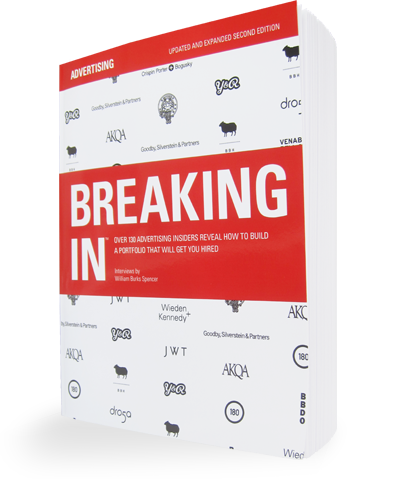Check out some great work from Paul Belford.
PB: … Advertising students are just bad at execution. And I wouldn’t expect them to be good because they haven’t had much experience in doing it. Especially art directors. And I don’t hold that against them. I mean, I’m happy to see a portfolio full of just scribbles as long as they’re good ideas. The most important thing is good ideas. And then you take a gamble when you hire someone, whether they’re going to become good at execution over a number of years or not. Some people will just have it and some people don’t. I think you’ve just got to have the desire to want to improve how your ideas are executed. And some people honestly really don’t care. They’re happy that they’ve done a great idea and someone else can just kind of plonk it on the page and run it. I think that’s a terrible shame.
So personally, I want people who have great strategies and ideas, and then also have the desire to execute those strategies and ideas to a higher level. So that’s what I look for from advertising graduates. But I don’t necessarily expect to see it in the portfolio. I just want to see scribbles and ideas. And ideas for anything actually, I really don’t care. Just someone who can have ideas—interesting ideas.
WS: So when you’re looking at design skills, how do you want to see that, if not in the book?
PB: I don’t think you can judge it. I don’t think you judge it in a young kid. They can certainly talk about it. I’d interview someone; when I was looking at their work, we’d talk about what kind of work they like, if they’d seen exhibitions, what kind of designers they’d like, if they had any favorite designers, things like that. And someone who can articulate a point of view about design is certainly more interesting than someone who just kind of shrugs and says, “Oh, I don’t know.”
WS: Right. It’s interesting because in the US, no one really takes around sketches anymore. Everything is completely comped up.
PB: I know and they all look like shit. I was in [New York] judging the One Show this year, and I did some portfolio reviews as part of that week. And I couldn’t believe all these…I mean you’re getting it more and more here. But I would say, “What’s the point?” These people who spent hours on the Mac doing these kind of dreadful layouts with horrible stock shots and terrible type. And it just kind of puts me off. It’s a good idea in there somewhere but it’s got this veneer of awfulness over it. So I’m a kind of lone voice in that. I know that’s the way the business has gone. American agencies would probably be horrified if someone turned up with some scribbles. So there’s no easy solution to that.
WS: But your point of view is the ideas come first?
PB: Absolutely.
WS: And sketches are fine for that. And then once they’re in the business, they can start with creating things on a computer?
PB: Yeah. And it takes years for an art director to become a good art director, I think. Years and years. So I don’t expect it. I don’t even look for it, to be honest. I just want to look for the desire to improve execution. Ideas certainly come way, way higher up the scale than the ability to know what buttons to press on the computer.
WS: Okay. And about writing and demonstrating the ability to write…do you hire writers here?
PB: I’m currently looking to hire a writer. We have interns who have been on advertising courses. But one thing that really frustrates me when I’m looking at student books is the lack of copywriting ability. You often see entire books, even without any attempt at headlines. And I don’t think every campaign should be constructed that way, but I think it’s a really important skill to have. It’s a useful string to your bow if you have that ability, just to write a decent headline. I think it’s a fashion thing, it goes in cycles, and everyone does really simple, visual ideas where the only words usually are an end line explaining the strategy and then a logo. And that’s the kind of way most student campaigns are constructed these days. And it’s fine, but it’s just one way of doing it. It’s good to demonstrate a breadth of skills in terms of how you execute campaigns.
[ … ]

Comments are closed.